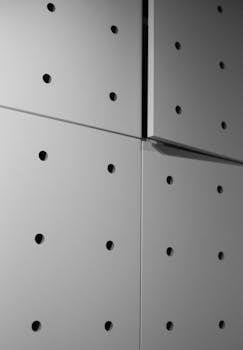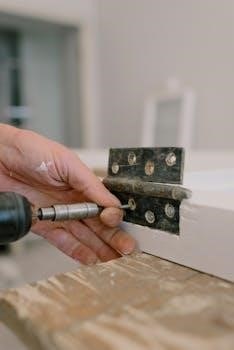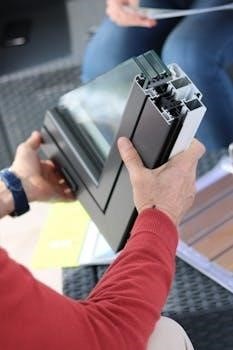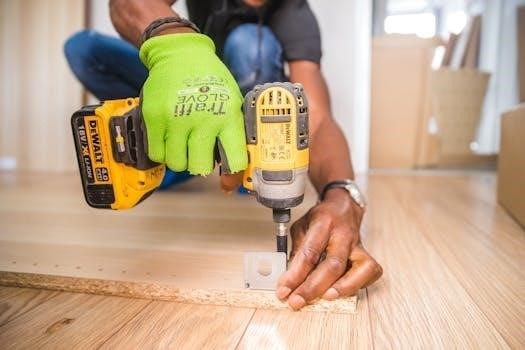Honeywell TH8321R1001 Installation Guide
This comprehensive guide provides step-by-step instructions for installing the Honeywell TH8321R1001 thermostat. Follow these instructions carefully to ensure correct installation, optimal performance, and seamless integration within your home’s HVAC system. Safety first!

Initial Steps
Before beginning the installation, gather necessary tools and materials. Next, carefully read all safety warnings and instructions included in the manual. Proper preparation is crucial for a successful installation and safe operation.
Separating the Wallplate
The first physical step in installing your Honeywell TH8321R1001 thermostat involves separating the wallplate from the thermostat body. This is a crucial initial step to allow for mounting the wallplate securely on the wall. Locate the button, usually found at the top of the thermostat. Gently press this button while simultaneously pulling the thermostat away from the wallplate. This action should release the thermostat, allowing you to access the mounting holes on the wallplate. Ensure that you handle both the thermostat and wallplate carefully to avoid any damage during separation.
Mounting the Wallplate
With the wallplate now separated, you are ready to mount it securely to the wall. Position the wallplate on the wall at the desired location, ensuring it is level for aesthetic purposes and proper thermostat function. Use a pencil to mark the locations for the mounting screws through the provided holes on the wallplate. Pre-drill pilot holes at these marked locations. If mounting on drywall, use appropriate wall anchors for added support. Finally, align the wallplate with the pilot holes and securely screw it into place, ensuring it is firmly attached to the wall.
Wiring
Proper wiring is essential for the Honeywell TH8321R1001 to function correctly. Carefully follow the wiring diagrams provided in this guide to connect the thermostat to your heating and cooling system. Ensure all connections are secure!
Wiring for Standard Systems
For standard systems, the wiring of your Honeywell TH8321R1001 thermostat is crucial for proper operation. Begin by identifying the existing wires connected to your old thermostat. Use the provided wiring diagrams to match the wires to the appropriate terminals on the new thermostat’s wallplate. Common terminals include R, W, Y, G, and C. Ensure each wire is securely connected to its corresponding terminal. Double-check the connections against the wiring diagram to avoid any errors. Incorrect wiring can lead to system malfunction or damage, so precision is key. If unsure, consult a qualified HVAC professional.
Wiring for Two-Transformer Systems
Wiring the Honeywell TH8321R1001 for two-transformer systems requires special attention. Unlike standard systems, two-transformer setups have separate transformers for heating and cooling. In such cases, it’s essential to isolate the power supplies to prevent damage. Remove any factory-installed jumpers between the Rh and Rc terminals. Connect the heating transformer’s R wire to the Rh terminal and the cooling transformer’s R wire to the Rc terminal. Ensure the common wires from each transformer are also correctly connected. Refer to the wiring diagrams specific to two-transformer systems in the installation manual for precise guidance. Verify all connections before powering on the system.

Installer Setup
Accessing installer options allows customizing the thermostat’s configuration. Enter the date code to unlock advanced settings. Modify parameters to match your specific system requirements for optimal performance and energy efficiency.
Accessing Installer Options
To access the installer options on your Honeywell TH8321R1001 thermostat, begin by touching the “Menu” button on the thermostat’s display. Next, carefully select the “Installer Options” from the menu choices presented on the screen. At this point, the thermostat will prompt you to enter a password. This password is the date code. Once you have entered the correct date code, touch “Done”. This will grant you access to the advanced installer settings. Now you can modify parameters to fine-tune its operation.
Setting the Date Code
The date code functions as a password, protecting advanced settings from unauthorized changes. To set or find your Honeywell TH8321R1001’s date code, consult the product packaging or related documentation. This code is vital for accessing installer options. Once located, carefully note the date code; it’s essential for future adjustments. If you’ve misplaced the original documentation, check Honeywell’s website or contact their support for help. Remember, the date code ensures secure modification of the thermostat’s sophisticated installer configurations, maintaining system integrity and preventing unintended alterations.
RedLINK Accessories
The Honeywell TH8321R1001 seamlessly integrates with RedLINK accessories, enhancing its functionality. These accessories include wireless sensors and gateways, allowing for remote control and expanded system management capabilities for your home.
Pairing RedLINK Devices
To harness the full potential of your Honeywell TH8321R1001, pairing it with RedLINK devices is essential. This process establishes a wireless connection, enabling communication between the thermostat and accessories like remote sensors or the RedLINK Internet Gateway. Begin by accessing the thermostat’s menu and navigating to the “RedLINK Setup” or “Wireless Manager” option, usually found within the installer settings. Follow the on-screen prompts to initiate the pairing mode. Ensure that your RedLINK device is also in pairing mode, typically activated by pressing a button or following its specific instructions. Once both devices are in pairing mode, the thermostat should automatically detect the accessory. Confirm the pairing on the thermostat’s screen, and the devices will be linked, expanding your control over your home’s comfort.
Mounting Considerations for RedLINK Performance
Optimal placement of your Honeywell TH8321R1001 and RedLINK accessories is crucial for reliable wireless communication. To ensure robust RedLINK performance, maintain a minimum separation of two feet between the thermostat and other RedLINK devices. Avoid placing the thermostat in areas obstructed by metal objects or thick walls, as these can interfere with the wireless signal. Consider the range limitations of RedLINK technology, especially when positioning remote sensors in distant parts of your home. Experiment with different locations to find the best signal strength and minimize potential interference. Proper mounting will maximize the responsiveness and reliability of your RedLINK system, providing seamless control over your home’s comfort settings.

Thermostat Placement
Choosing the right location for your Honeywell TH8321R1001 thermostat is essential for accurate temperature readings and optimal HVAC system performance. Consider factors like airflow, sunlight, and wall type during placement.
Optimal Location within the Home
For optimal performance of your Honeywell TH8321R1001 thermostat, placement is key. Choose a central indoor location where you spend the most time, such as the living room or kitchen. Avoid areas near doorways, windows, or exterior walls, as these can experience temperature fluctuations that will affect the accuracy of your thermostat.
Mount the thermostat approximately 1.5 meters (about 5 feet) above the floor, ensuring easy access and visibility. Also, ensure the location has good air circulation, away from heat sources like lamps or appliances. Following these guidelines will result in efficient control.
Avoiding Direct Sunlight and Exterior Walls
To guarantee accurate temperature readings and prevent false triggers, avoid installing your Honeywell TH8321R1001 thermostat in areas exposed to direct sunlight. Sunlight can artificially inflate the thermostat’s temperature, causing your HVAC system to underperform or overwork. Similarly, avoid mounting the thermostat on exterior walls. These walls are prone to temperature fluctuations caused by the outside weather and can negatively impact performance.
Choose an interior wall, away from windows and doors, to ensure the thermostat accurately measures room temperature. Proper placement maximizes energy efficiency and maintains consistent comfort throughout your home.
Powering Options
The Honeywell TH8321R1001 offers flexible powering options to suit your needs. You can choose between battery power for simple setup or a hardwired connection for reliable, continuous operation. Select the option best for your home.
Battery Power
The Honeywell TH8321R1001 thermostat can operate on battery power, providing a convenient and easy installation option. This eliminates the need for wiring to a power source. Ensure you use high-quality alkaline batteries for optimal performance and longevity. When the battery is low, the thermostat will display a warning, prompting you to replace them. Battery power is ideal for situations where a hardwired connection is not readily available or desired. Remember to properly dispose of old batteries according to local regulations. Regular battery checks are recommended to prevent unexpected thermostat shutdowns and maintain consistent functionality.
Hardwired Connection
Alternatively, the Honeywell TH8321R1001 thermostat can be hardwired to a 24VAC power source for continuous operation. This eliminates the need for batteries, providing a reliable power supply. Ensure the wiring is performed by a qualified technician, following all local electrical codes and safety regulations. A common wire (C-wire) is often required for consistent power delivery. Double-check the wiring connections to prevent short circuits or damage to the thermostat or HVAC system. Hardwiring ensures uninterrupted operation, especially beneficial for critical climate control applications and RedLINK functionality.

Connecting to Wi-Fi (If Applicable)
If your Honeywell TH8321R1001 model includes Wi-Fi connectivity, this section outlines the steps to connect it to your home network. Ensure your Wi-Fi network is active and you have the network name (SSID) and password readily available. Access the thermostat’s menu and navigate to the Wi-Fi settings. Select your network from the list of available networks and enter the password when prompted. Once connected, the thermostat will display a Wi-Fi icon, indicating a successful connection. This enables remote access and control via the Honeywell Home app.
Troubleshooting
This section addresses common issues encountered during and after the installation of the Honeywell TH8321R1001. If the thermostat is not powering on, verify the battery installation or hardwired connection. For connectivity issues, double-check Wi-Fi credentials and network stability. If the system isn’t responding to thermostat settings, ensure proper wiring and system configuration. Error codes displayed on the screen can be referenced in the user manual for specific solutions. If problems persist, consult a qualified HVAC technician for further assistance. The date code might be required.
